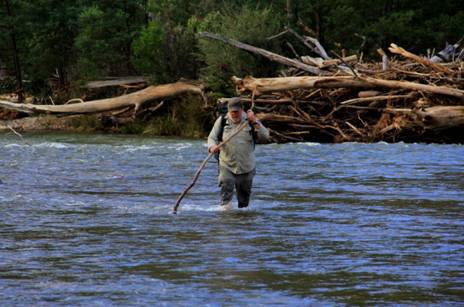River Crossings: This is one of the most fraught parts of hiking. I have seen so many people come to grief doing this (and have had to arrange emergency air rescue for a number who foolishly injured themselves). For example, many folks will spend lots of time trying to find a log to cross on. Please, don’t. If you fall off the log you will certainly not be in the best place to cross and may be swept to your death; if you needed a log it probably wasn’t safe to cross anyway, and you may be injured by the fall. Logs are round and slippery; you will need perfect balance – difficult wearing a heavy pack anyway. Forget it!
Secondly, don’t remove your shoes and cross barefoot. A badly injured foot miles from safety/your vehicle etc is a recipe for disaster. Many river bottoms (also) conceal broken glass even in the most remote places; anyway there are always sharp stones/sticks. Either put up with wet shoes or carry purpose river crossing (or camp) shoes, or just a pair of seal skin socks – 80 grams -so that you can have dry feet at night even with wet shoes: I recommend Crocs (300 grams/pair) as you CAN hike many kilometres in them if your hiking shoes give out or you happen to lose one eg down a hole, in the fire etc – or you could try making a pair of my ultralight thongs – 58 grams/pair; see ROPE 24/02/2015.
Before you cross carefully choose your spot. Calm water is best. A long ‘still’ patch of river (even if you have to swim) is safer than a fast moving section with lots of rocks (even if shallower). If you have to swim, swim diagonally downstream having carefully worked out that the speed of the current will allow you to get across in the section chosen. Obviously a long, slow shallow section is best of all (eg as pictured).
You should have your gear in a waterproof pack liner, your sleeping bag, clothes sat phone etc inside another waterproof bag inside the liner. I use THREE nested waterproof bags for my sat phone! It is your most important survival aid – apart from what is/isn’t between your ears! It is a good idea to ensure there is plenty of AIR inside your pack liner so you can use your pack as a kick board if you have to swim (I have, many times!) I use the Sea to Summit Ultrasil bags. Check them from time to time for waterproofness (when you’re home!) by filling them with water to see if they leak. If they do the supplier WILL replace them, or they can be seam sealed again. You can even blow up your inflatable mat either (partially) inside your pack or tie your pack to it for extra buoyancy.
If you can safely wade, obtain a stout stick to make for a third leg, so you always have two points of purchase on the river bottom. Cross (at least slightly) facing INTO the current which is the most stable stance. Thirdly, if you are wearing your pack rather than using it as a flotation device.
ALWAYS UNDO the pack straps. You don’t want to be bowled along in fast water with the pack strapped to your back! That’s an excellent way to drown! If you have a rope USE it (see post about ROPE http://www.theultralighthiker.com/rope-dont-leave-home-without-it/).
Lastly, if it isn’t safe to cross, DON”T: wait for the water to go down or find an alternative route – either upstream (smaller) or downstream (flatter) – topography will decide your choice. You can live for a month without food; you can live for about a MINUTE underwater!
See also: http://www.theultralighthiker.com/river-crossings-2/

See Also:
http://www.theultralighthiker.com/how-to-light-a-fire-in-the-wet/
http://www.theultralighthiker.com/rope-dont-leave-home-without-it/
http://www.theultralighthiker.com/finding-your-way/
http://www.theultralighthiker.com/the-lie-of-the-land/
http://www.theultralighthiker.com/the-importance-of-a-roof/
http://www.theultralighthiker.com/carry-a-knife/
http://www.theultralighthiker.com/if-you-could-only-carry-two-things-in-the-bush-what-would-they-be/
http://www.theultralighthiker.com/ultralight-poncho-tent/
http://www.theultralighthiker.com/the-pocket-poncho-tent/
http://www.theultralighthiker.com/naismiths-rule/
http://www.theultralighthiker.com/weather-lore/
http://www.theultralighthiker.com/walking-the-line/
http://www.theultralighthiker.com/follow-your-nose/
http://www.theultralighthiker.com/how-long-till-sundown/
http://www.theultralighthiker.com/how-to-avoid-being-wet-cold-while-camping/
http://www.theultralighthiker.com/fire-on-the-snow/
http://www.theultralighthiker.com/river-crossings/
http://www.theultralighthiker.com/an-open-shelter/
http://www.theultralighthiker.com/raincoat-shelter/

I haven’t forded anything yet deeper than my calf, but I am keen on the idea! Thanks for all the great tips. You really get around on the walks, and I am quite envious… 🙂